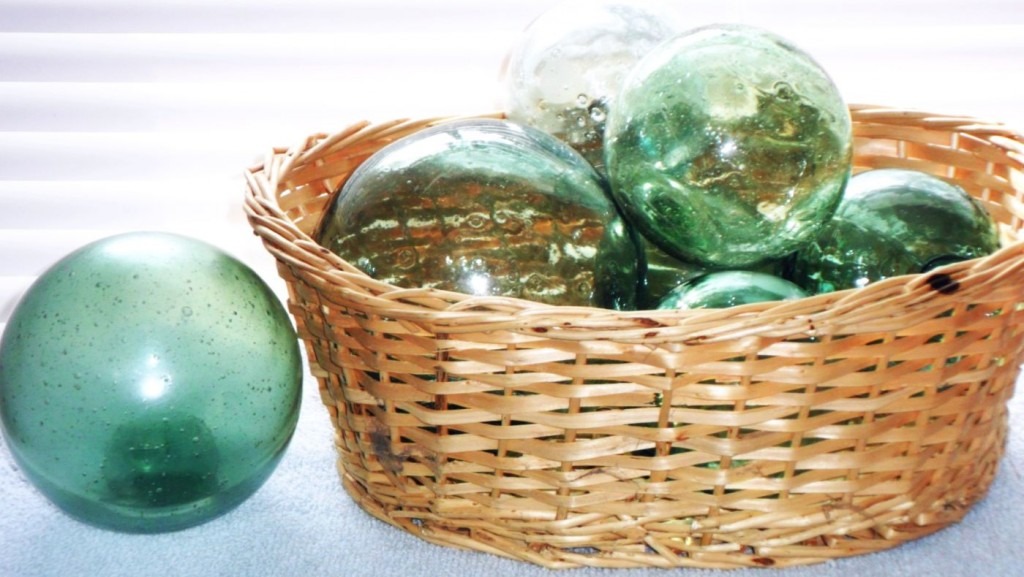
Many glass collectors are not yet familiar with this type of glass collectible, unless they live along the Western coasts of the US, or have seen them for sale at antique shops or gift shops. Every so often, especially after strong storms accompanied by long-continued onshore Westerly winds have passed through, beachcombers in Oregon, Washington and other areas have found these hollow glass balls cast up onto the beach along with driftwood and other flotsam and jetsam.
These hollow glass spheres were used on ocean waters to support large scale commercial fishing nets, (often with many individual fishing nets strung together, sometimes several miles in extent) and to keep these nets from sinking. Floats range in size from a golf ball to a tennis ball or grapefruit, up to, in rarer instances, a soccer ball or even a basketball.
Note: small fishing floats are sometimes confused with several other kinds of round glass balls, including Christmas ornaments, glass target balls (which were used in trap shooting during the late Victorian era – please see this page here on Antique Glass Target Balls ) or lightning rod balls (decorative glass balls installed on lightning rods on buildings, especially Midwestern barns in the US during the late Victorian era). Other more obscure types of glass balls have been made, including the so-called “witch balls” (hung from windows to ward off evil spirits as early as the 1700s in England) and hollow glass balls that supposedly served as jar stoppers. Some glass balls might have been blown as random novelties or “whimsies” by glassblowers employed in early factories. Most of those types of balls have also been reproduced in modern times.
Origin & early manufacture
Norway is believed to have been the first country to start production and use of glass fishing floats. Christopher Faye, a Norwegian merchant from Bergen, is credited for their invention in the early 1840s.
The first time these glass fishing floats are mentioned is in the production records for the Hadeland Glassverk (Glassworks) of Jevnaker, Norway, in 1842. The earliest evidence of glass floats actually being used by fishermen comes from Norway in 1844 where glass floats were on gill nets in the great cod fisheries at Lofoten. However, it is believed by some researchers and collectors that glass floats had already been in use in Norway and other Scandinavian countries for many years before this time.
Japan apparently started using the glass floats as early as 1910. By the 1940s, glass had evidently replaced wood or cork floats for a good percentage of deep-sea or large-scale commercial fishing operations throughout much of Japan, Europe, Russia, and North America.
Several countries produced machine-made glass floats, including the United States. In the U.S., during the 1930s or 1940s the Owens-Illinois Glass Company (Diamond and oval with I); Northwestern Glass Company, Seattle, Washington (“NW” mark) ; Corning Glass Works; and Crystallite Products, Glendale, California, manufactured machine-made floats, which are usually found in clear glass. Some made by Northwestern Glass are known in amber.
Glass floats have, over the last several decades been replaced, for the most part, by floats made of aluminum, plastic, or Styrofoam. However, it is somewhat unclear whether glass float production for ocean fishing purposes is completely obsolete……….yet. In the reference work Beachcombing the Pacific by Amos L. Wood (published as recently as 1987), Wood writes “Blown glass floats are still the mainstay of the oriental long line tuna fishery with it’s hand labor operation, while plastic floats are standard with the American salmon gill net fishery that employs hydraulic-driven winch blocks to do the net hauling. The handblown glass float has not been replaced by plastic in other kinds of oriental fishery, popular opinion to the contrary, for the glass float is still the least expensive [my emphasis].” Evidently there are still some small glass-blowing operations in Japan and other Asian countries that are producing floats actually made for fishing, but most floats today are probably being made more for the tourist collector trade than for actual fishing purposes.
ADVERTISEMENT
Today, the majority of glass fishing floats that are adrift on the Pacific Ocean originated in Japan because it had a large deep sea fishing industry which made extensive use of these floats; other very similar-looking floats are/were also made by glass companies located in Taiwan, Korea and China.
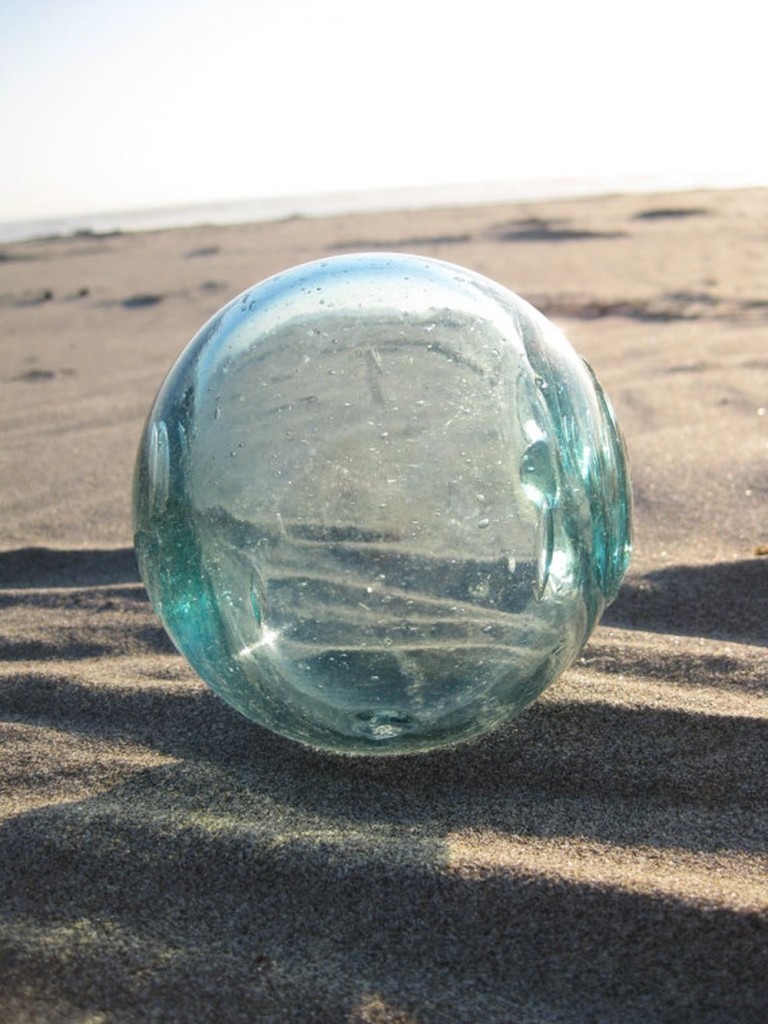
The great majority of authentic glass fishing floats (those actually made for the fishing industry, NOT for the gift shop trade or made intentionally just for sale to collectors), are made of glass in some shade of AQUA (blue-green or turquoise), or pale green.
Less common, but still found fairly often in some areas (Europe or Caribbean), are floats in medium to dark greens, such as dark olive green. Other colors are much rarer. Some floats are found in very pale amethyst (purple) glass. Most of those may have been originally clear, but have turned an amethyst color (from exposure to ultraviolet rays of the sun) if the glass contained enough manganese. Medium or dark purple (authentic) floats are extremely scarce.
Most authentic floats have many bubbles and impurities (specks of carbon, firebrick, etc.) embedded inside the glass. They were typically made partly, or wholly, of recycled glass (waste glass, cullet) from old bottles, including used Japanese Saki wine bottles.
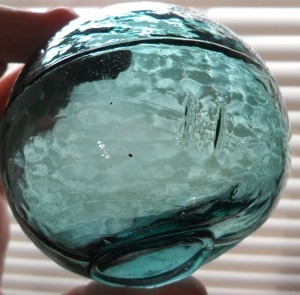
Colors that have occasionally been found in authentic floats include light to medium blue (not aqua) , brown, gray, shades of amber, cobalt blue, yellow, and the very rarest are believed to be in shades of red or orange.
Reproduction floats
Most floats that are in an unusual color such as cobalt blue, dark purple, bright yellow, rich bright green, orange, or red, can be safely assumed to be a modern reproduction, made especially as a “tourist gift item” unless there is strong evidence to prove otherwise (meaning, the float was actually found washed up on a beach).
Most colored floats sold on internet auction sites are modern production (repros) that never saw service “in the wild”. Many of them are probably current (or very recent) products of Asia. The majority (although certainly not all) of the reproduction / gift-shop floats (replicas, or “fakes”) tend to have thinner, weaker walls, and usually do not have as many bubbles embedded in the glass. They are often covered with weak, thin, poorly-made netting that would not stand up to actual hard use in the ocean environment.
The most commonly found authentic floats range in size from about the size of an orange up to a grapefruit. Other floats, both smaller, and much larger, are found. The largest floats are very hard to find. Although most fishing floats are round (spherical), there are several scarcer types of floats known as “rolling pins” or “rollers”.
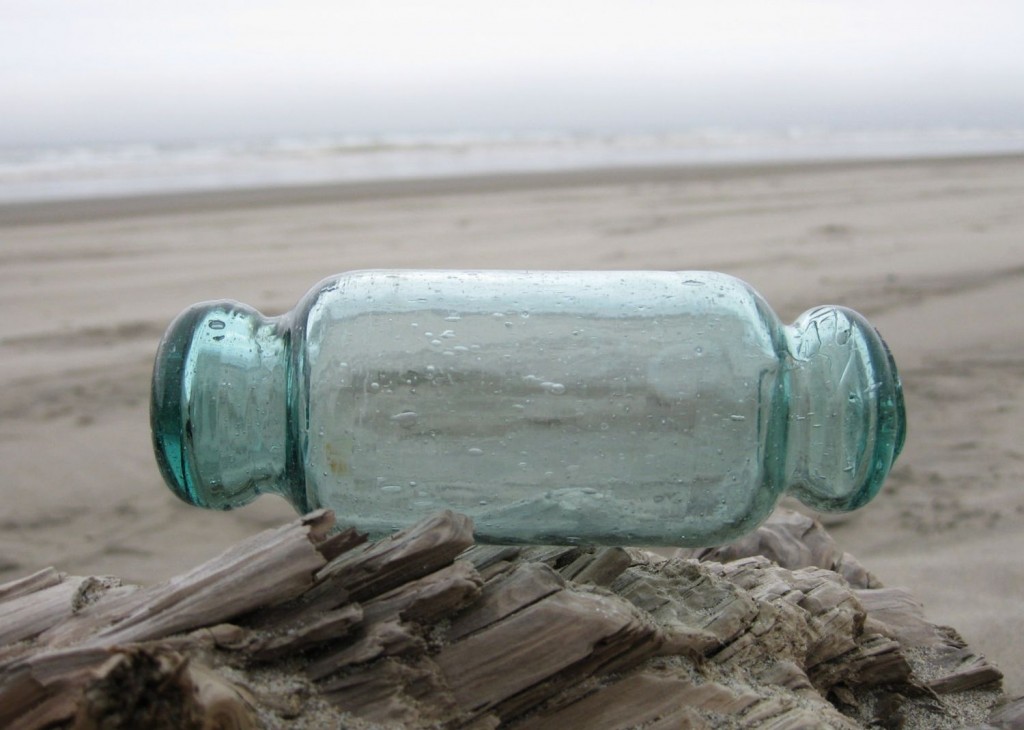
In many cases, the larger floats are broken when they are cast up onto rocky shores (which is one reason why they are found so infrequently). Their chances of being found unbroken are much better when they are cast by the surf onto a smooth, sandy, relatively level beach.
ADVERTISEMENT
Some percentage of floats are found with a dull “frosty” matte look, caused by the surf action, i.e. rolling around on a sandy beach. Floats are often used as decorative accents in homes. Collectors sometimes arrange them on shelves, or in back-lit glass display cases, or displayed artistically in sunny windows along with other decorative or collectible items such as shells, rocks, bottles, crab pot markers, old buoys and other maritime/ nautical artifacts.
The earliest floats, including most Japanese glass fishing floats, were handmade (usually free-blown) one by one, by a professional glassblower. After being blown, floats were removed from the blowpipe and sealed with a “button”, “patch”‘ or “plug” of molten glass, before being placed in a lehr (cooling oven). Incidentally, this “button” is not the same thing as a “pontil mark”” as seen on bottles. Some hand-made floats of Oriental origin were made by blowing the glass into a mold.
Some of the molds that were used are reported to have been made out of wood, although it is likely that most were made of metal (cast iron or steel). Some percentage (perhaps 10 to 20 percent) of floats have some type of raised marking on them that presumably indicates the glassmaker.
Many of the floats made in Japan or Korea have markings, although a lot of these marks are not identified as to exact origin or glassmaker. The book “Beachcombing for Japanese Glass Floats” by Amos L. Wood (mentioned at the bottom of this article) illustrates a wide variety of markings that have been documented on these floats, including examples from Japan, Korea, the United States, Great Britain, Germany, Czechoslovakia, Norway, and Portugal.
Today, a lot of the glass floats remaining in the ocean are “stuck” in a circular pattern of ocean currents in the North Pacific. Off the eastern coast of Taiwan, the Kuroshio Current starts as a northern branch of the western-flowing North Equatorial Current. That current flows past Japan and eventually meets the Arctic waters of the Oyashio Current. At this junction, the North Pacific Current (or Drift) is formed which travels east across the Pacific before gradually turning south to become the California Current.
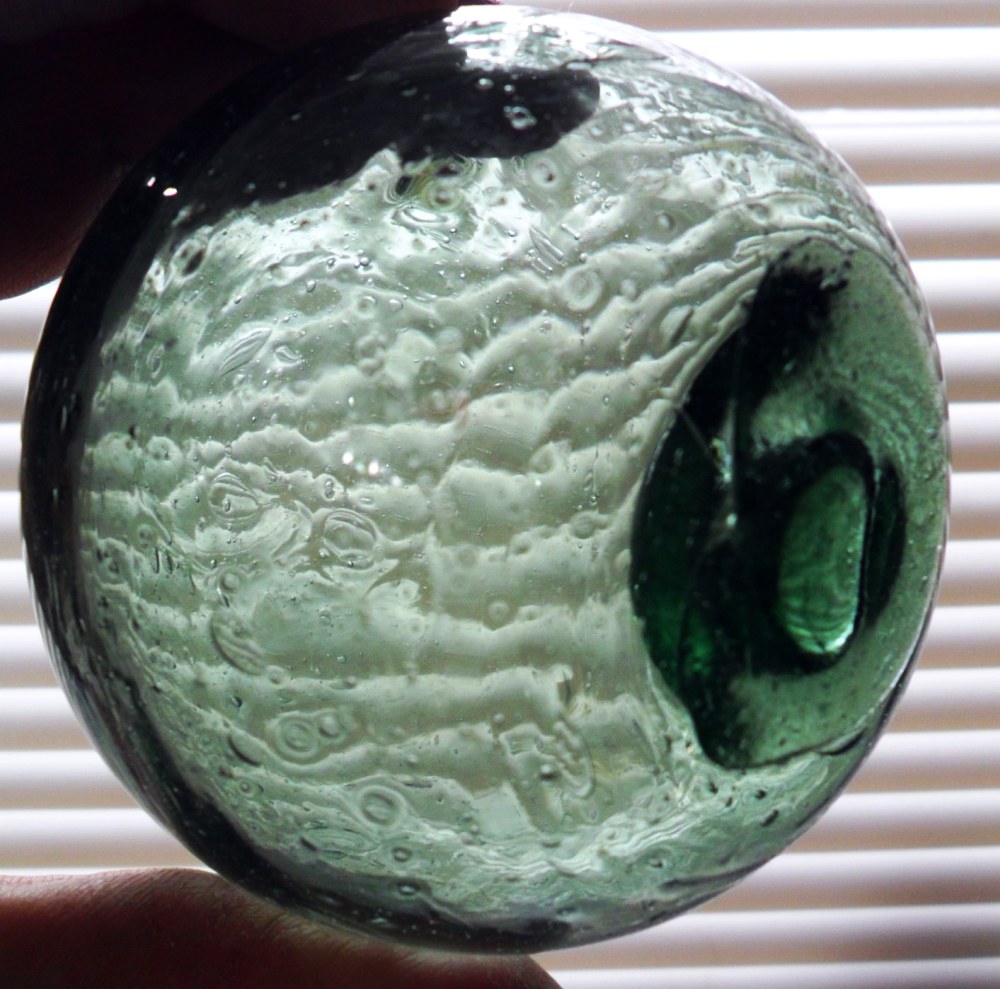
The California Current pushes the water into the North Equatorial Current once again, and the cycle continues indefinitely. Although the number of glass floats can be assumed to be gradually decreasing, many floats ( probably millions of them) are still drifting along on ocean currents. Heavy storms, especially those with strong and long-continued westerly winds, occasionally push floats out of these large-scale current systems, and eventually those floats may wind up on the beaches of the West coast, most commonly those of Oregon, Washington, and Alaska. Floats are occasionally found along the Baja California coast. Port Heiden, in Alaska, has the distinction of being an area where many floats have been found, especially after intense storms have been through the area.
At other locations around the Pacific Rim area, including Wake Island and Hawaii, floats are also found. There are probably many lost glass floats that are now more or less “becalmed” in the center of the large Pacific Ocean circulation “gyre” (somewhat similar to the “Sargasso Sea” region of the Atlantic Ocean) drifting slowly along with large quantities of other debris that has washed into the ocean from rivers and streams that flow from land masses encircling the entire Pacific Rim area.
Glass floats are also found along some Atlantic Ocean beaches, including areas in the Caribbean, but not quite as often as on the shores of the Pacific Ocean. Floats found in European areas might be more likely to be seen in “true” medium or darker greens, as compared to Asian floats which are more likely to be in shades of aqua. (Apparently, many of the older floats made in Great Britain appear in shades of dark olive green).
ADVERTISEMENT
REFERENCES
For much more information, I would heartily recommend the classic book on the subject: Beachcombing for Japanese Glass Floats, by Amos L. Wood. (1985 and earlier editions). Some of the information on this webpage is taken from that reference work, and credit must be given to Mr. Wood for his extensive research on the subject. His follow-up book is called Beachcombing the Pacific, and in that book he discusses beachcombing for all kinds of interesting items, including those made of glass as well as other materials.
Also, some more recently published reference books on glass floats with tons of superb information include:
Glass Ball by Walter Pich (2004).
Glass Fishing Floats of the World by Stu Farnsworth & Alan D. Rammer (2005).
Glass Ball Marks by Walter Pich (2009). This has an extensive list of embossed marks seen on Japanese fishing floats!
Glass Ball Shapes – Rolling Pins & Sausages by Walter Pich (2014).
WEBSITES
“Glass Fishing Floats” by Tom Rizzo. Beautiful photos of many colorful floats, showing lots of markings: https://www.theglassmuseum.com/fishingfloats.htm
Kamichia Rudnick’s website with lots of good info and floats for sale: https://glassfloatjunkie.blogspot.com/
Tom Rizzo’s (“The Sea Hermit”) website, with many links to float and float-related subjects: https://seahermit.blogspot.com/
There are also glass fishing float discussion groups on Facebook, including this one: Glass Fishing Floats group on Facebook
For an extensive list of glass manufacturers’ marks seen on bottles, fruit jars, electrical insulators and other glassware, please click here to go to the Glass Bottle Marks pages (starting here on page one).
Click here to go to my website Home Page.
ADVERTISEMENT


David,
My grandfather was stationed as lighthouse keeper with the USCG on Tatoosh Island off the coast of Washington State some time in the late 60s or very early 70s. My grandmother, father, and aunt lived on the island too along with one other family. My grandfather would walk the beach daily and found a glass float washed up on the beach. He tied a rope net around it and I remeber it hanging in their family room while growing up. I now have the float and am hanging it in my front room. Do you have any research into the manufacturers logos or markings on these floats. My grandfather always assumed it was of Japanese origin. The markings on this float look like one character back to back with its mirror image.
Thanks for the article,
Mike
Hi Mike,
What a great story and a wonderful keepsake! Thanks a lot for posting. Well, to be honest, the best advice I can give you is to defer to the author of the latest comprehensive books on oriental glass floats and markings seen on them: Check the internet for reference books written by Walter Pich. He has published at least 4 books, and two of these would be ideal for the float collector: “Glass Ball” and “Glass Ball Marks”. You can probably find these and check for the best prices by searching on eBay, Amazon, Etsy, Alibris, Abebooks, and/or Bookfinder. Hope this helps!
David
What are metal spots embedded into glass?
David:
I have an aqua colored glass float that has been in my family for at least 80 years. It has a circumference of about 45 inches. Its most unique feature is that it has about a cup of water sealed inside it. Do you know what percentage of glass floats have water sealed inside? I have always been curious about that. Enjoyed reading your informative material here.
Thank you.
Lyn
Hi Lyn,
I don’t know what percentage of floats contain water but I’d guess it would be less than 0.1%. It is my understanding that the water has very, very slowly seeped into the float (while drifting on the open ocean) through tiny crevices in the glass, presumably cracks located along the perimeter of the sealed “button” or “cap” of glass (the molten glass cap having been added as a last step by the glassblower), as seen on handmade floats.
Take care, David
Hey David, I have a question regarding the type of line traditionally used on Japanese glass floats. I acquired one while in Yap but it doesn’t have any line around it and I want to go ahead and dress it up nicely to display in my home but I’m unsure what the best looking and most traditional type of natural line to use. Thanks for any insight you can provide!
Hi Robert,
I must be honest and tell you I am not sure about the ropes and lines used on the various floats over the years. I would guess they often used some type of strong jute, hemp, or similar fibers, but I don’t really know, and have not researched the subject in depth. I would suggest you join one of the glass fishing float discussion groups on Facebook, where lots of knowledgeable collectors check in often. You would likely get some good feedback on this if you posted some queries there.
Hope this helps,
David
I have an old fish net that appears to be jute with wax coating. I used it for valances and hung beach treasures on it. I believe that is the same type used on the floats. I have several floats of different kinds but haven’t found a photo of one that was found by a friend in Alaska decades ago. It appears to be two pieces with a black heavy band around the joining of the two. I’ve never seen another like it and was hoping to find out about it.
I found an aluminum float-about 6 inches around-no marks or seal in Northern Japan. Do you have any info about them?
Hi Steph,
No, I’m sorry but I don’t know anything about the aluminum floats.
~ David
When we lived in Alaska in the 70’s and 80’s, we found “hundreds” of them in various sizes as we would go beach combing on the weekends with my parents. That was a great family experience with my parents and siblings.
I sure do miss those carefree days!
Hi Garrett,
That sounds wonderful! I’d love to go beachcombing along the shores of Alaska!! Thanks for your post~
David
Good read – I have about 200 large floats and thousands of small ones – various colors, some with rope, some without, a number still have barnacles, some have markings – the beauty of these beachcomber treasures is no 2 floats are alike, just wish I could have been beachcombing in the 60’s! 🙂
Thank you Robert for your post! And I totally understand! It appears that it is getting harder to find floats cast up on the beaches nowadays. But, on the bright side I am sure there are considerable numbers still out there, floating on the open ocean, perhaps waiting for the next big storm to bring them onshore!
Best regards,
David
Thank you for mentioning Wake Island! I have two or three dozen glass balls collected there in the mid-1960’s.
Sam, thank you for your post! I’m sure you had great fun finding glass floats washed up along the beaches at Wake Island! Take care and best regards,
David
My Grandmother found many in the late 60s early 70s o n the Florida Keys. I have and LOVE them!